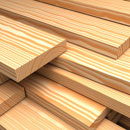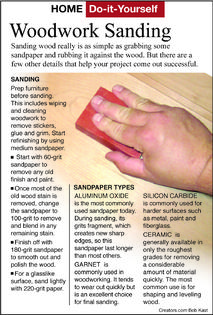Here's How: Proper Sandpaper Makes Projects Easier
Dear James: Our century-old house has natural woodwork, but most should be refinished. How do I decide what types and grits of sandpaper to buy and which to use where? -- Deandra R.
Dear Deandra: As you mentioned, there are not only many types of sandpaper materials, but the roughness (grit) and the type of abrasive materials also vary. The information on the packaging generally is not helpful and usually is just for marketing stating how long the sandpaper with last.
There is not one best type of sandpaper for all your refinishing projects. The most effective type depends on the material that you plan to sand and the end result that you desire. In your case, you may want a professional-looking slick, glossy finish or your natural oiled wood.
The first major categories of sandpapers are open or closed paper. Open paper has only about 70% grit coverage, which leaves spaces between the particles. This works well with wood. The open spaces keep the sandpaper from loading up and clogging with the wood dust. Closed sandpaper is better for use on metal or other hard materials.
Next you must determine the grit to buy. A smaller grit number means a larger, coarser grit size. The number refers to the number of holes per square inch in a sieve. In order to get 220 holes per square inch, the holes must be smaller than in a 60-holes-per-square-inch sieve. Smaller holes allow only smaller particles of abrasive to pass through.
You will often start out with a coarse 60-grit paper and sand across the wood grain. This removes a lot of wood quickly to remove any small nicks and scratches. Next you can use a 100-grit paper and sand with the grain.
Prior to finishing, use a 180-grit paper for a smooth surface. If you have plenty of time, light sanding with 220-grit paper will yield a glasslike surface. This is also a good grit to use between coats of urethane.
Your final selection decision is the type of grit. Sandpaper does not actually use sand. There are four basic abrasive grit materials, and each has its specific advantages for various materials you are finishing.
Aluminum oxide is the most common material you will find, and it is one of the best for use on raw and painted wood. It is inexpensive. It usually has a light brown color, and as you use it, the aluminum oxide particles fracture. This is good because it continuously creates new sharp edges.
Red garnet is another grit material that is often used on wood, especially for the final finishing. It is orange or red in color. As you use it, the relatively soft abrasive particles tend to dull (since it's not self-sharpening like aluminum oxide). This dulling makes it easier to get a mirrorlike surface on the wood prior to finishing with urethane.
The other two types of grit that you will find are silicon carbide (black) and ceramic (reddish brown). Silicon carbide is very hard and self-sharpens somewhat; it is best for metals, plastics and other synthetic materials. Ceramic grit is most often used on power belt and pad sanders.
Although you mentioned only sandpaper, there are some fairly new sanding "sponges" that can be washed and reused many times. These are comfortable to the hand and are ideal for sanding wood with curved surfaces. Since they form to curved surfaces, they tend to provide a more uniform sanding action. These sanding pads are available in many grits just like regular sandpaper.
========
Send your questions to Here's How, 6906 Royalgreen Dr., Cincinnati, Ohio, 45244 or visit www.dulley.com. To find out more about James Dulley and read features by other Creators Syndicate writers and cartoonists, visit the Creators Syndicate website at www.creators.com.
Copyright 2024 Creators Syndicate Inc.







